Ride the National Mall! – eWheel Going Out Group
< Click here to go back to RSVP page
*** It’s a great day for an ewheel ride. See you there! ***
UPDATE #1: The email with my cell no. has been sent to the yes RSVPs. TEXT me if you need to. If you do not see my email, check your spam folder, and also make sure your email and Meetup settings allow for you to always receive messages from the organizer. If it’s not there, send me a message through my Meetup profile with your cell no. See you there!
—
Let’s get together for our next ride!

Riders from previous Meetups (Anibal, Ben, Brandon, Chris, Dave, Edwin, Erwin, Haitao, Heather, James, Jessica, Joe, Jonathan, Kevin, Kris, Loren, Mark, Megan, Melissa, Michael, Rakesh, Raul, Richard, Robert, Rodney, Shelly, and Steven), come join us again! New riders, come join us for the first time!
Two years ago, we rode the National Mall as our very first ride, and it’s about time we go back! It won’t be the exact same route, but similar. We’ll stop numerous times along the way to enjoy the sites, memorials, landmarks, and to also let some of the slower riders catch up (if some of us decide to go at a quicker speed). Ideally, we will all ride together and at the same speed, but that may or may not be possible with other pedestrians, bicyclists, etc. sharing the same paths, but let’s do our best please! In total, it’s an ~8 mile trip that’s sure to be enjoyable!
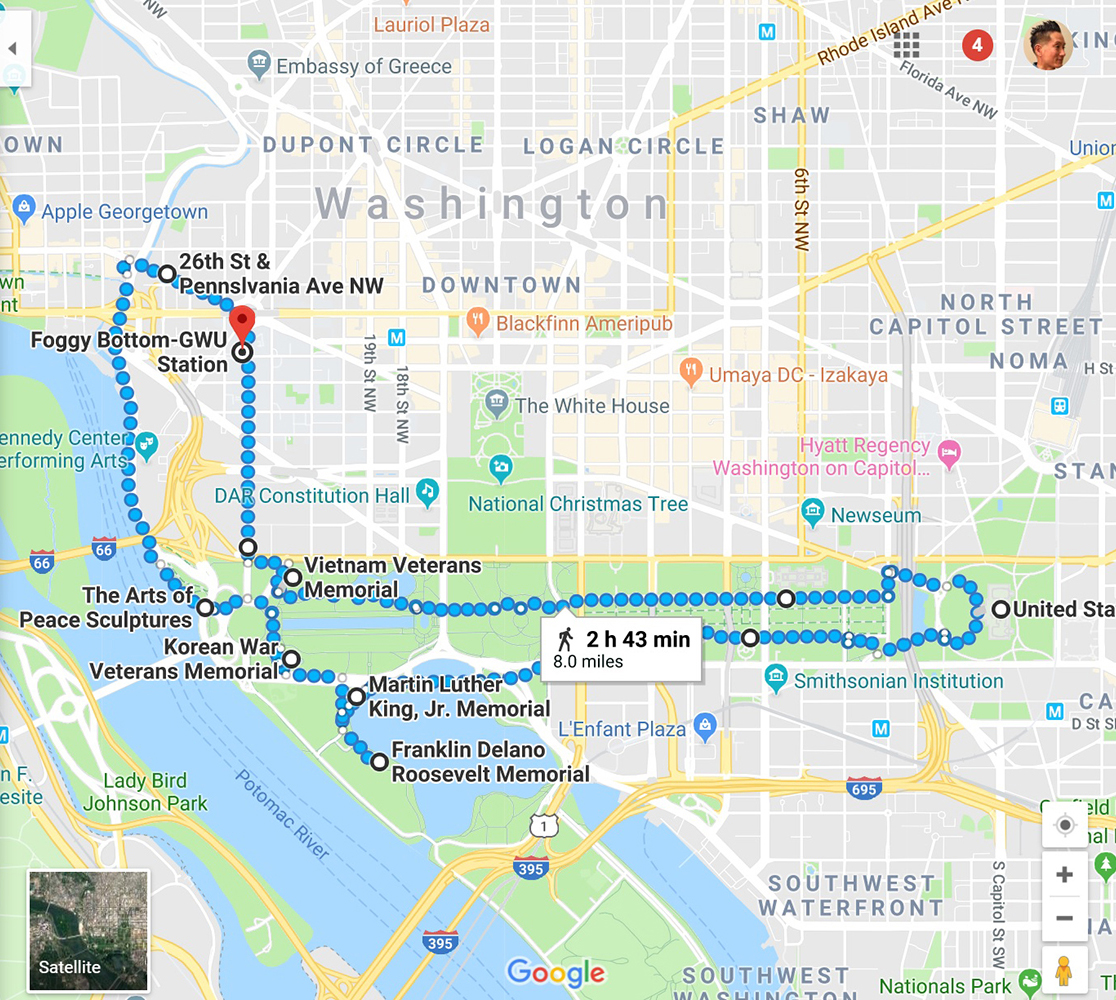
(National Mall ride overview)
We’ll meet up at the Foggy Bottom Metro at 2pm. Then we’ll ride south along 23rd Street NW for ~1 mile, at 2:30pm. Once we come across Constitution Avenue NW, we’ll make a left and ride for 0.1 miles.
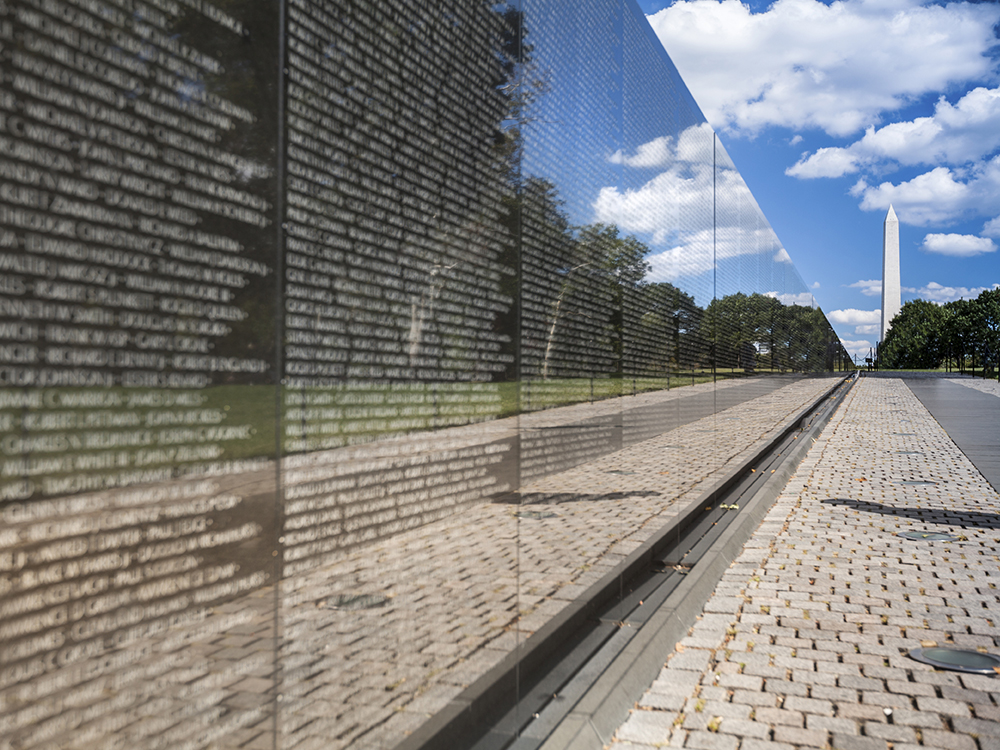
(Vietnam Veterans Memorial)
Then we’ll turn right onto Henry Bacon Drive NW for 500 feet and arrive at the Vietnam Veterans Memorial. The Vietnam Veterans Memorial is a 2-acre U.S. national memorial. It honors service members of the U.S. armed forces who fought in the Vietnam War, service members who died in service in Vietnam / South East Asia, and those service members who were unaccounted for (missing in action, MIA) during the war. The memorial consists of three separate parts: the Vietnam Veterans Memorial Wall, completed first and the best-known part of the memorial; The Three Soldiers, and the Vietnam Women’s Memorial. The memorial receives around 3 million visitors each year. The Memorial Wall was designed by American architect Maya Lin. In 2007, it was ranked tenth on the “List of America’s Favorite Architecture” by the American Institute of Architects.
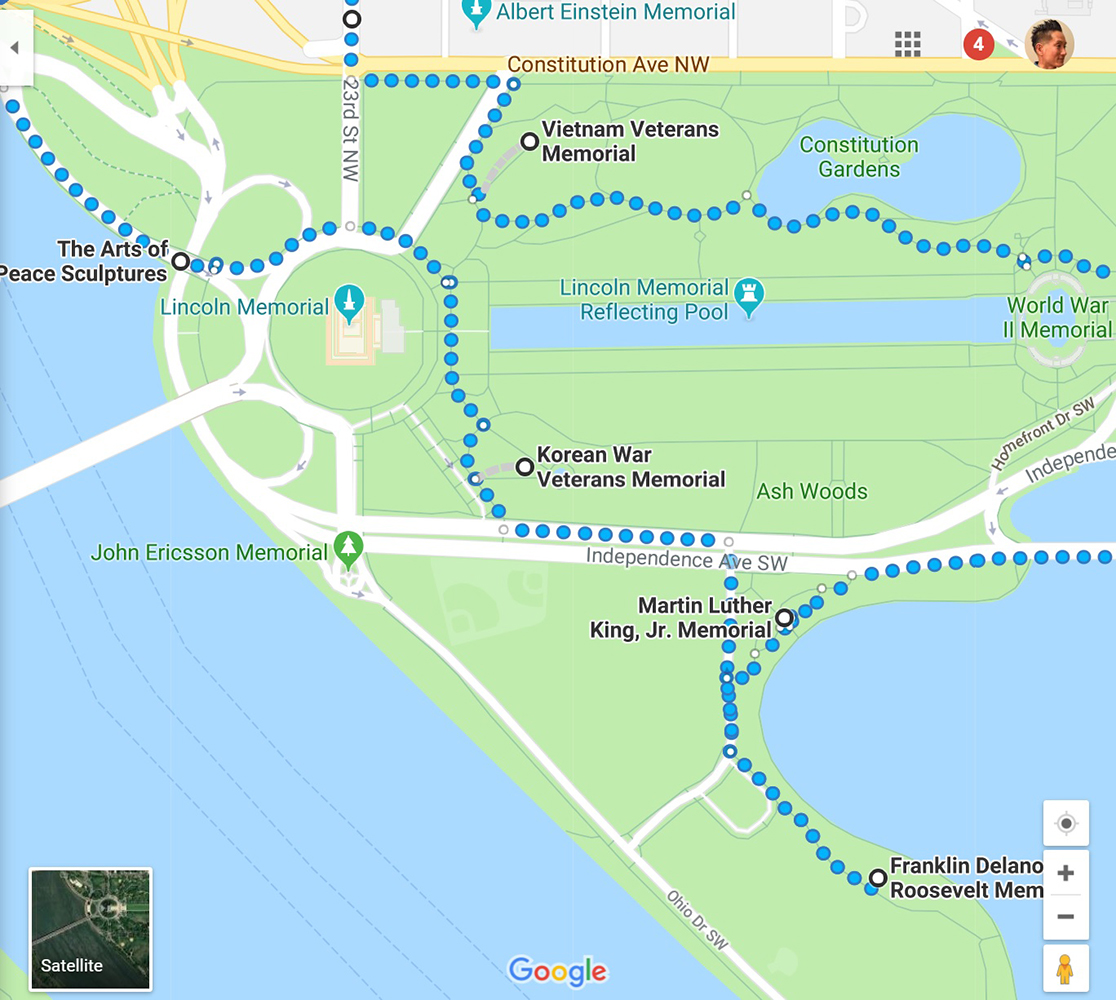
(Head east to Constitution Gardens)
We’ll then head east for ~0.2 miles.
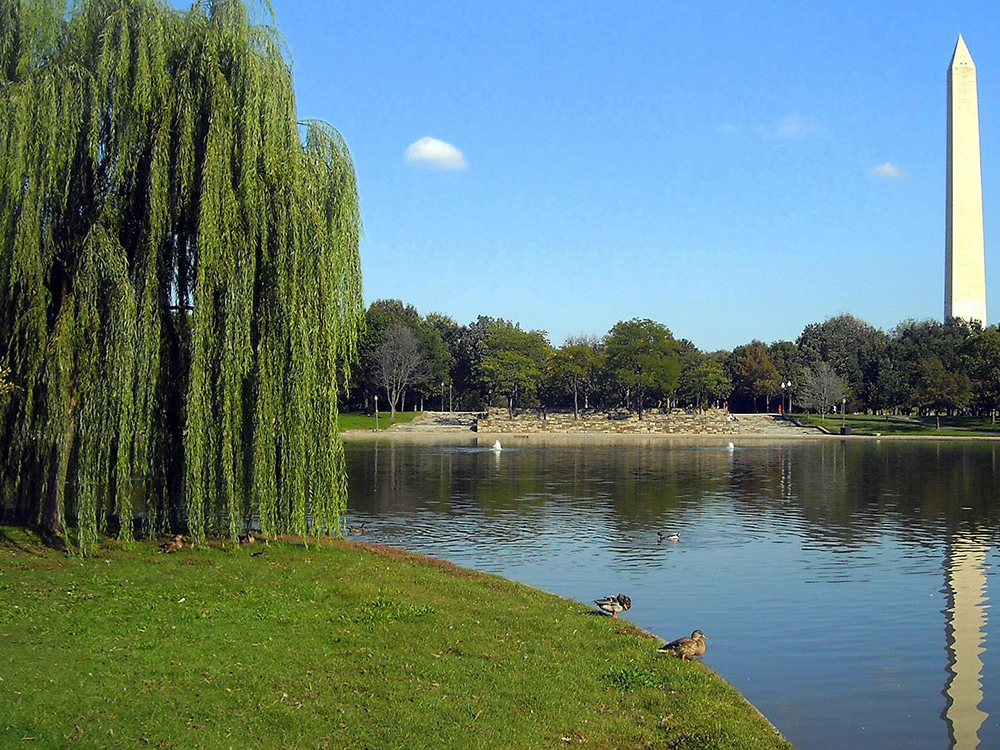
(Constitution Gardens)
Next, we‘ll come across Constitution Gardens. The land that became Constitution Gardens was originally submerged beneath the Potomac River and was dredged at the beginning of the 20th century by the Army Corps of Engineers. President Nixon ordered that a park be established on the land, and in 1976, Constitution Gardens was finally dedicated as a “living legacy American Revolution Bicentennial tribute.” In July 1982, the Memorial to the 56 Signers of the Declaration of Independence was dedicated on the small island in the lake. On September 17, 1986, President Ronald Reagan formally proclaimed the park a “living legacy tribute” to the United States Constitution, in honor of the bicentennial of the U.S. Constitution one year later. As home to famous monuments, Constitution Gardens continues to have millions of visitors every year. It is also the site of an annual naturalization ceremony for new U.S. citizens hosted by the National Park Service.
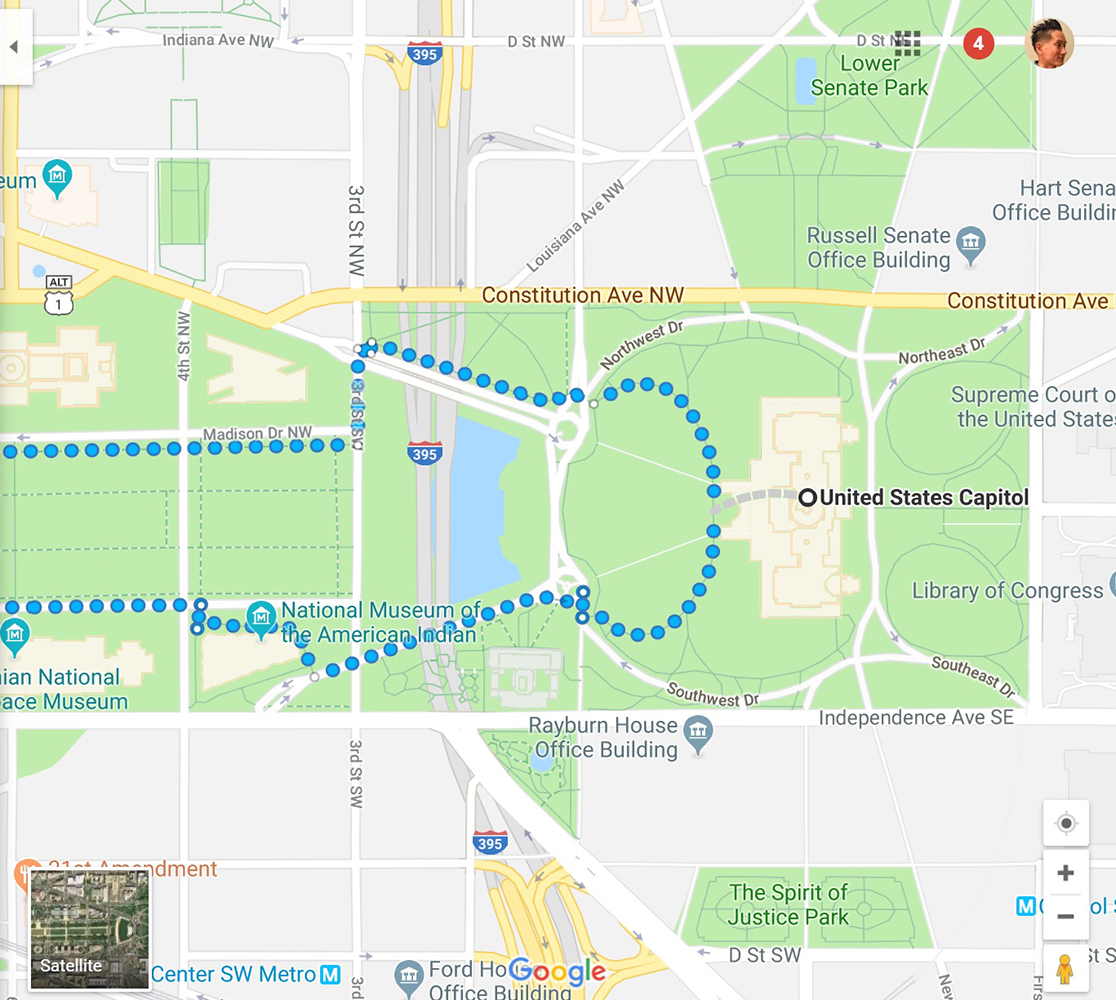
(Head east to the National Mall)
We’ll head east for ~1.2 miles.
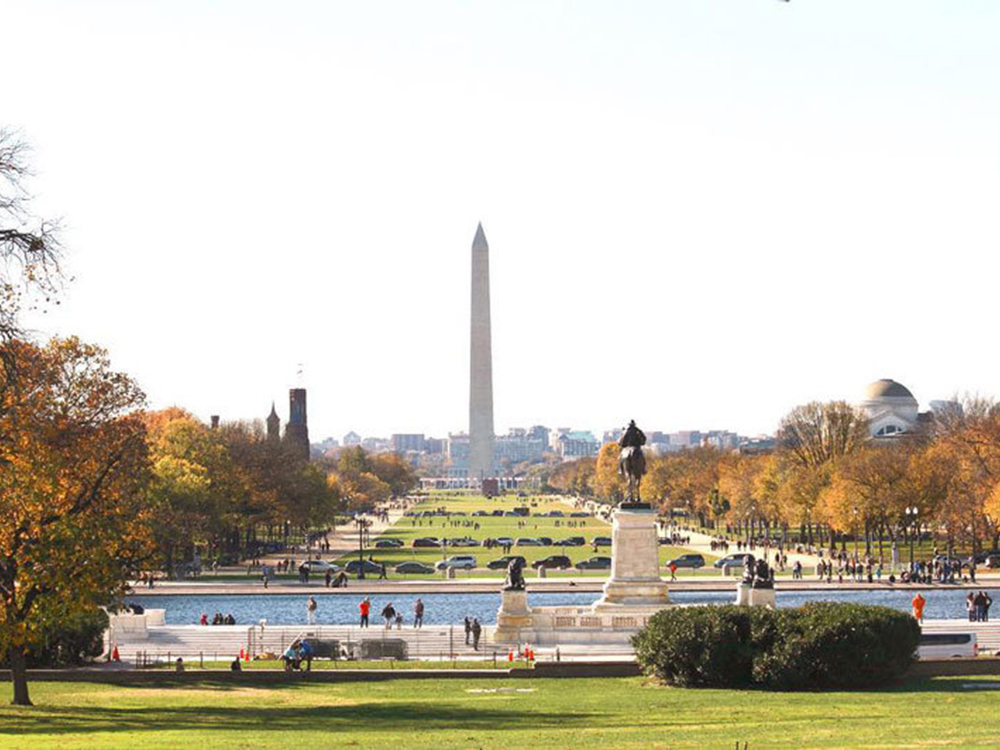
(National Mall)
We’ll then arrive on the National Mall. The National Mall is a landscaped park within the National Mall and Memorial Parks, an official unit of the United States National Park System. The term National Mall commonly includes areas that are also officially part of neighboring West Potomac Park and Constitution Gardens to the southwest. The term is often taken to refer to the entire area between the Lincoln Memorial on the west and east to the United States Capitol grounds, with the Washington Monument dividing the area slightly west of its midpoint. A smaller designation sometimes referred to as the National Mall (proper) excludes both the Capitol grounds and the Washington Monument grounds, applying only to an area between them. The National Mall contains and borders a number of museums of the Smithsonian Institution, art galleries, cultural institutions, and various memorials, sculptures, and statues. The park receives approximately 24 million visitors each year.
From the National Mall, we’ll head directly east for ~1 mile to the U.S. Capitol.
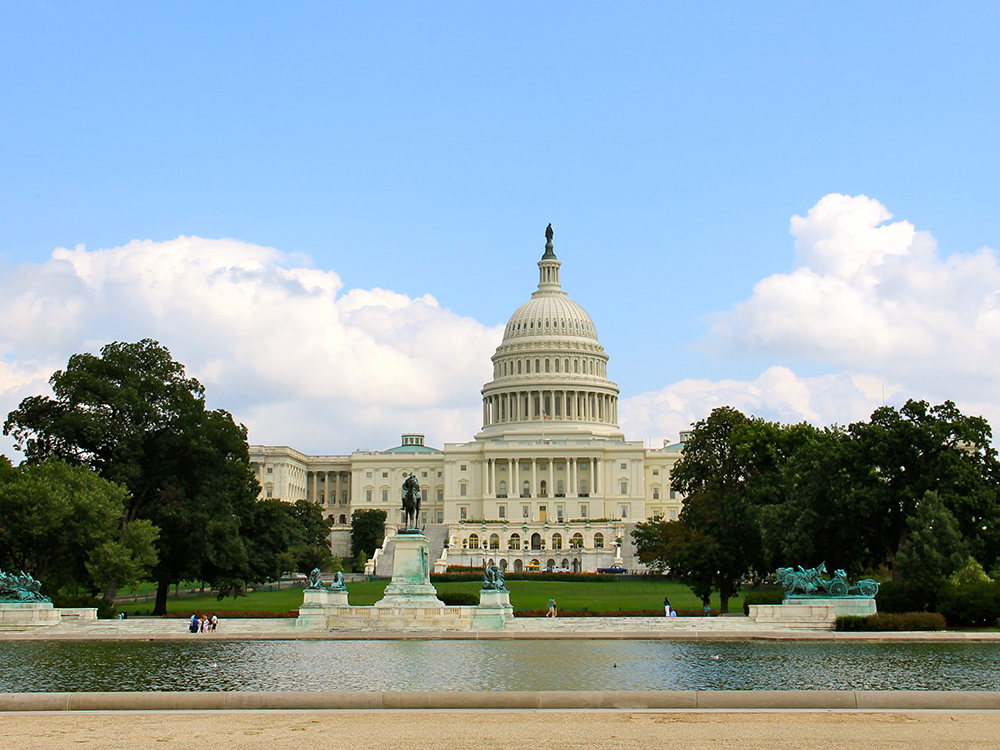
(U.S. Capitol)
The United States Capitol, often called the Capitol Building, is the home of the United States Congress, and the seat of the legislative branch of the U.S. federal government. It is located on Capitol Hill at the eastern end of the National Mall in Washington, D.C. Though no longer at the geographic center of the Federal District, the Capitol forms the origin point for the District’s street-numbering system and the District’s four quadrants. The original building was completed in 1800 and was subsequently expanded, particularly with the addition of the massive dome, and expanded chambers for the bicameral legislature, the House of Representatives in the south wing and the Senate in the north wing. Like the principal buildings of the executive and judicial branches, the Capitol is built in a distinctive neoclassical style and has a white exterior. Both its east and west elevations are formally referred to as fronts, though only the east front was intended for the reception of visitors and dignitaries.

(Head west to the Martin Luther King Jr. Memorial)
From the U.S. Capitol, we’ll then travel ~2 miles west on the National Mall and Independence Ave SW.

(Martin Luther King Jr. Memorial)
We’ll come across the Martin Luther King Jr. Memorial. The Martin Luther King Jr. Memorial includes the Stone of Hope, a granite statue of Civil Rights Movement leader Martin Luther King carved by sculptor Lei Yixin. The inspiration for the memorial design is a line from King’s “I Have A Dream” speech: “Out of the mountain of despair, a stone of hope.” The memorial opened to the public on August 22, 2011, after more than two decades of planning, fund-raising, and construction. This national memorial is the 395th unit in the United States National Park Service. The official address of the monument, 1964 Independence Avenue SW, commemorates the year the Civil Rights Act of 1964 became law. A ceremony dedicating the memorial was scheduled for Sunday, August 28, 2011, the 48th anniversary of the “I Have a Dream” speech that Martin Luther King Jr. delivered from the steps of the Lincoln Memorial in 1963 but was postponed until October 16 (the 16th anniversary of the 1995 Million Man March on the National Mall) due to Hurricane Irene. Although this is not the first memorial to an African American in Washington, DC, King is the first African American honored with a memorial on or near the National Mall and only the fourth non-President to be memorialized in such a way.
From there, we’ll turn left on West Basin Drive SW for ~0.3 miles and arrive at the FDR Memorial.
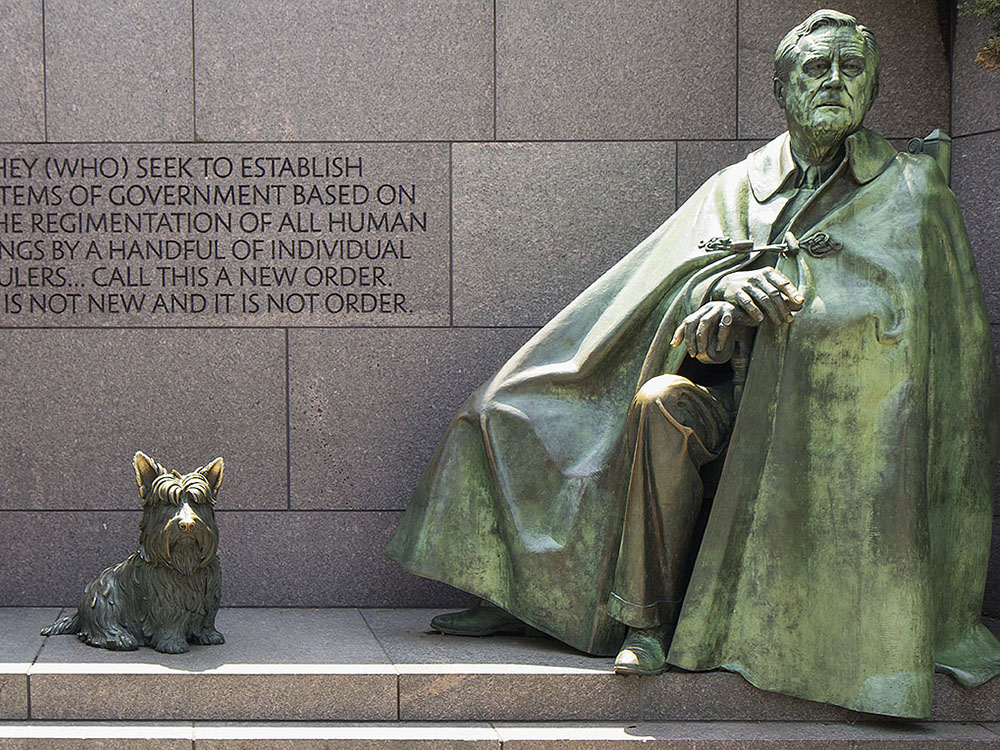
(Franklin Delano Roosevelt Memorial)
The Franklin Delano Roosevelt Memorial is dedicated to the memory of Franklin Delano Roosevelt, the 32nd President of the United States, and to the era he represents. Dedicated on May 2, 1997 by President Bill Clinton, the monument, spread over 7.5 acres, traces 12 years of the history of the United States through a sequence of four outdoor rooms, one for each of FDR’s terms of office. Sculptures inspired by photographs depict the 32nd president alongside his dog Fala. Other sculptures depict scenes from the Great Depression, such as listening to a fireside chat on the radio and waiting in a bread line, a bronze sculpture by George Segal. A bronze statue of First Lady Eleanor Roosevelt standing before the United Nations emblem honors her dedication to the UN. It is the only presidential memorial to depict a First Lady. Considering Roosevelt’s disability, the memorial’s designers intended to create a memorial that would be accessible to those with various physical impairments. Among other features, the memorial includes an area with tactile reliefs with braille writing for people who are blind. However, the memorial faced serious criticism from disabled activists. Vision-impaired visitors complained that the braille dots were improperly spaced and that some of the braille and reliefs were mounted eight feet off of the ground, placing it above the reach of most people.
Next, we’ll turn right on West Basin Drive SW and head north for ~0.3 miles, then turn left on Independence Ave SW for ~0.2 miles.
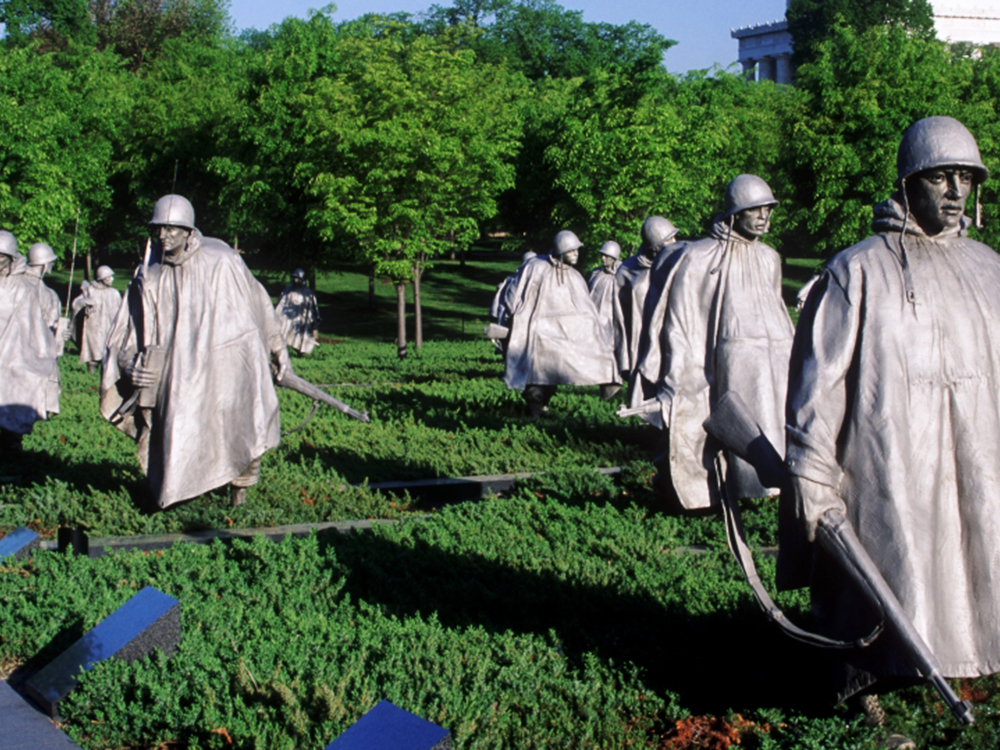
(Korean War Veterans Memorial)
We’ll arrive at the Korean War Veterans Memorial. Korean War Veterans Memorial memorializes those who served in the Korean War. The Mural Wall is the main memorial is in the form of a triangle intersecting a circle. More than 2,500 photographic, archival images representing the land, sea, and air troops who supported those who fought in the war are sandblasted onto the wall. When reflected on the wall, there appear to be 38 soldiers, 38 months, and it is also representing the 38 parallel that separated the North and South Korea. Within the walled triangle are 19 stainless steel statues, each larger than life-size. The figures represent a platoon on patrol, drawn from branches of the armed forces; fourteen of the figures are from the U.S. Army, three are from the Marine Corps, one is a Navy Corpsman, and one is an Air Force Forward Air Observer. They are dressed in full combat gear, dispersed among strips of granite and juniper bushes which represent the rugged terrain of Korea. To the north of the statues and path is the United Nations Wall, a low wall listing the 22 members of the United Nations that contributed troops or medical support to the Korean War effort. The circle contains the Pool of Remembrance, a shallow pool lined with black granite and surrounded by a grove of linden trees with benches. Inscriptions list the numbers killed, wounded, missing in action, and held as prisoners of war.
We’ll then continue north then west on Lincoln Memorial Circle NW for ~0.4 miles and arrive at the Arts of Peace Sculptures.
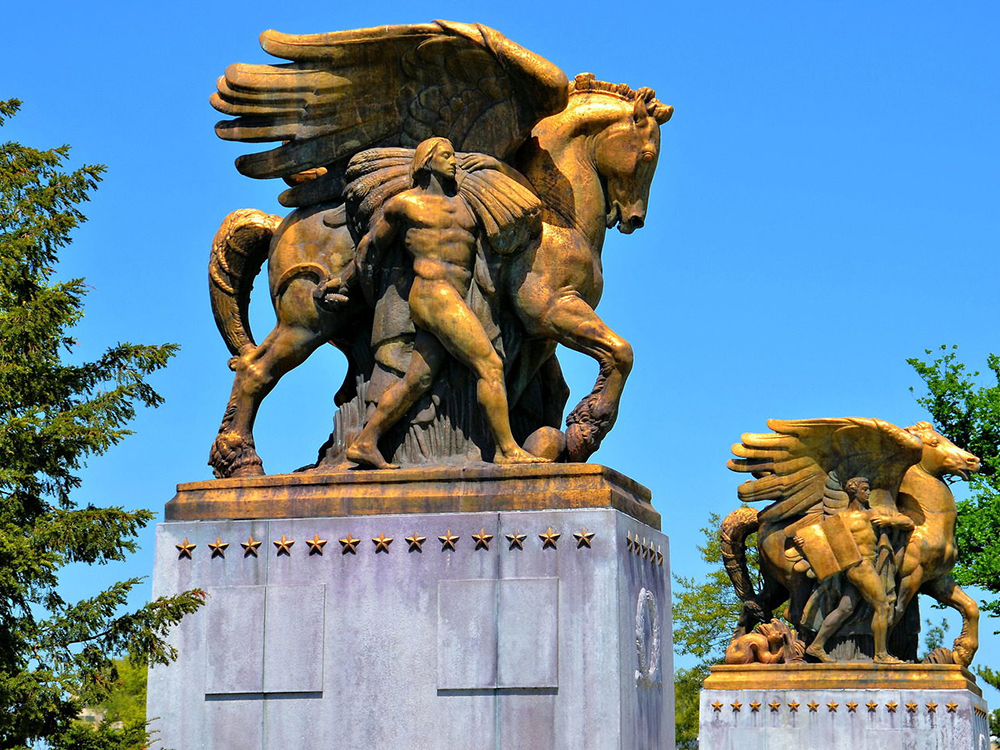
(The Arts of Peace Sculptures)
“The Arts of Peace” consists of two separate statuary groups, entitled “Aspiration and Literature”, which is on the left, and “Music and Harvest” on the right. These Neoclassical statues frame the entrance to the Rock Creek and Potomac Parkway. Both statues feature Pegasus, the source of inspiration and poetry in Greek mythology. “Aspiration and Literature” consists of a nude male on Pegasus’ right with a toga over his left shoulder and holding an open book, symbolic of literature. Another nude male on Pegasus’ left, dressed in a toga over both shoulders, is depicted aiming a bow backward, which is symbolic of aspiration. “Music and Harvest” consists of a nude male on Pegasus’ right holding a sickle and carrying a sheaf of wheat , symbolizing of harvest. A semi-nude female holding a harp, symbolic of music, is on Pegasus’ left. A turtle, symbolizing the belief that art is long and time is fleeting, is also present. The massive statues are the largest equestrian sculptures in the United States, with each weighing 40 tons, and measuring 19 feet high, 16 feet long and 8 feet wide. Each is mounted on a hollow granite pedestal which has 36 gilded bronze stars at the top, representing the number of states in the United States at the time of the Civil War.
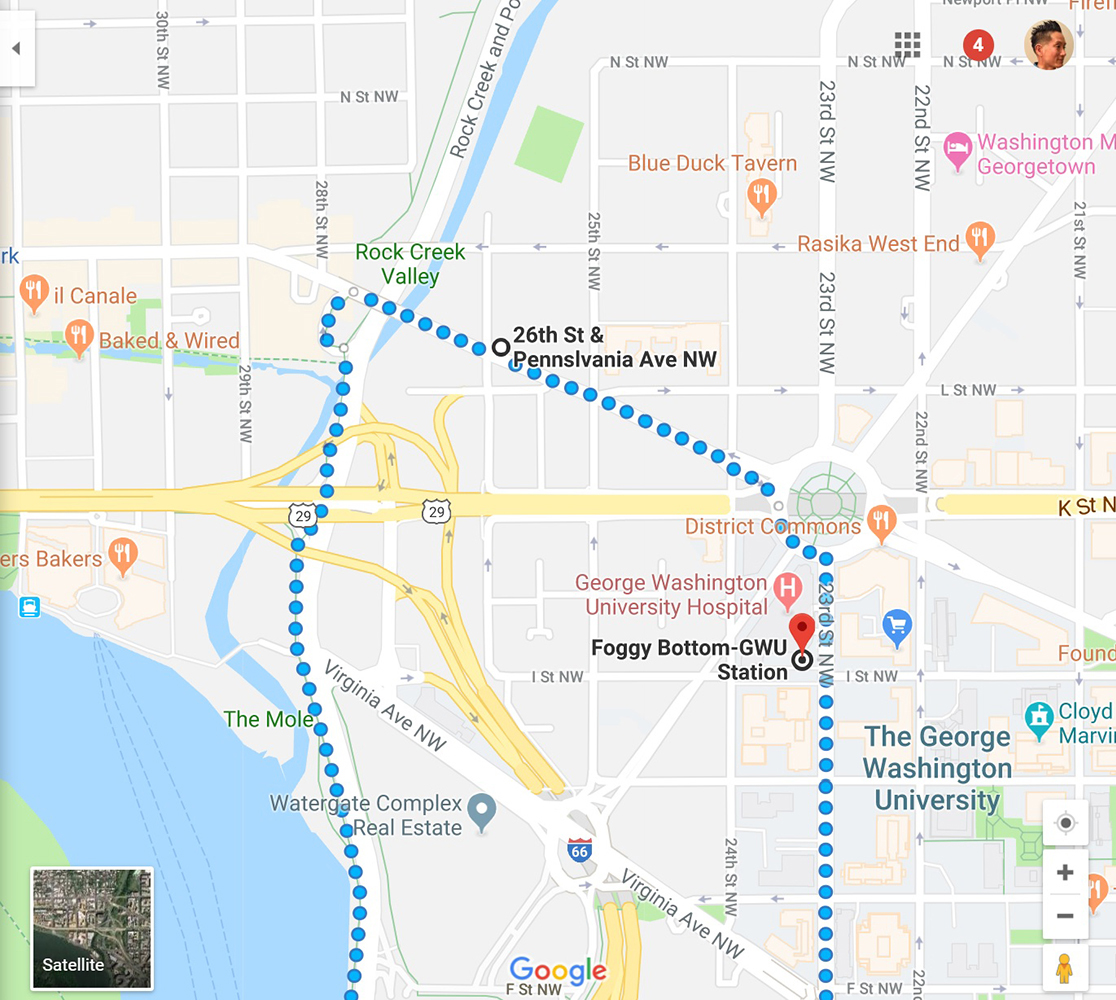
We’ll head north on Rockcreek and Potomac Parkway NW for ~1.2 miles until we arrive at Pennsylvania Ave NW. We’ll then make a right and travel for ~0.4 miles until we arrive at Washington Circle. From there, we’ll head directly south on 23rd Street NW for ~0.1 miles and return back to Foggy Bottom Metro.
Come join us as we spend an afternoon together exploring the sites, memorials, and landmarks the National Mall has to offer! Please also help spread the word of our group and event, especially since this is relatively new technology and we are a small community!
I look forward to seeing you there!
– J.T.
—
METRO & PARKING
We’ll meet at the Foggy Bottom Metro (Orange, Blue, Silver lines). I suggest Metro / cabbing / Uber’ing if you can. I also recommend using wmata.com for travel planning. Don’t forget to account for Metro, traffic, and parking delays. If you are driving, you will need to find street parking or a garage. I recommend using parkopedia.com for garage parking planning.
DRESS
Please dress appropriately for the weather. For those with problems having their feet go numb or tired during long rides, I recommend wearing shoes with a stiff and flat sole.
RIDING ETIQUETTE
Since e-wheels are relatively new technology, please be as courteous as possible to other pedestrians, bicyclists, etc. Being new, riding etiquette is not something that’s really been quite established. However, based on personal experience (I’ve been riding daily since 2015), I’ve noticed some general good practices and rules to follow. 1) ALWAYS give pedestrians the right of way. 2) When riding on a narrow sidewalk, and you’re coming up behind a pedestrian and you need to pass them, either a) wait until there’s an opening, or b) clear your throat and say “excuse me” in a *gentle* manner (I’ve noticed people tend to get startled / surprised when they see and hear a tall figure behind them on a wheel) before passing them. 3) SLOW DOWN to a pedestrian’s walking pace (until you are completely clear of them) whenever approaching or passing (whichever direction they are walking). Only after passing a pedestrian for a little distance is it a good idea to go faster than walking pace. Whatever you do, please do NOT wiz by them. 4) Thank the pedestrian as you are passing. 5) Slow down as you are going around a turn (whether there are other pedestrians in sight or not) with a lot of bushes or other obstacles next to the sidewalk, as they can be coming from the other end of the turn (and not be visible initially).
RIDING SKILL
For the safety of others and ourselves, we will all be required to be able to perform all of the following: (1) comfortably balance on the wheel while riding straight and turning left or right (2) ride at a snail’s pace and (3) start and stop comfortably without the need to hold onto any wall, post, or similar structure.
LEGALITY
People have asked me questions regarding the laws pertaining to riding our wheels in the DC metro area. I did a lot of research before purchasing my wheel to ensure I could make use of it. In short, they are considered Personal Mobility Devices or Electric Personal Assistive Mobility Device. (1) Virginia: “An electric personal assistive mobility device or motorized skateboard or foot-scooter may be operated on any highway with a maximum speed limit of twenty-five miles per hour or less. An electric personal assistive mobility device shall only operate on any highway authorized by this section if a sidewalk is not provided along such highway…” See link here. (2) Washington DC: “Personal Mobility Device (“PMD”) means a motorized propulsion device designed to transport one person, OR a self-balancing, two non-tandem wheeled device, designed to transport only one person with an electric propulsion system. Permitted on Sidewalk – Yes, except PMDs are generally not permitted on sidewalk space in the Central Business District. Permitted on Bike Lanes – Yes.” See link here. (3) Maryland: “‘Electric personal assistive mobility device’ or ‘EPAMD’ means a pedestrian device that: (1) has two nontandem wheels; (2) is self-balancing; (3) is powered by an electric propulsion system; (4) has a maximum speed capability of 15 miles per hour; and (5) is designed to transport one person” and “At an intersection, a person using an EPAMD is subject to all traffic control signals, as provided in §§ 21-202 and 21-203 of this title. However, at any other place, a person using an EPAMD has the rights and is subject to the restrictions applicable to pedestrians under this title.” De jure, the law applies to devices with 2 wheels, as the law was written when only Segways existed and electric unicycles, et al. did not. De facto, for practical purposes, and based on our members’ interaction with law enforcement officers thusfar, our devices have been treated as being covered under this statute (they are explicitly covered under DC and Virginia law). See link here and here. “Green” devices for the win!
RAIN
If there’s a greater than a 35% chance of rain, we’ll cancel or reschedule. I’ll post an update to the top of the event posting by 11:30am on the day of the event, and also send an email out to the yes RSVPs.
< Click here to go back to RSVP page
